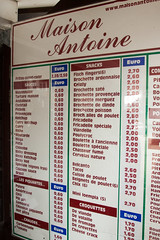As I mentioned in the previous review, Belgium has several well-known food items. The Belgian waffle (the gaufre de liege). Beer. Mussels (les moules). Chocolate. And frites. Yeah, us Americans may think that we love what we call French Fries, but the Belgians really have a serious thing going for their frites. So when my sister-in-law was taking us on a walking tour of Brussels showing us some of her old haunts, one of the places she took us was Maison Antoine.
Maison Antoine is a little stand in the Etterbeek section of Brussels in Place Jourdan, and quite frankly, they are the attraction for the area, with long lines snaking through the park up to the two ordering windows. And they’ve been there for quite a while, with the original stand opening on the same spot in 1948. While Maison Antoine nominally has a rather full menu of items (including such dubious items as “Chicken Sticks” and the “Carrero”, a McRib-like heavily processed pork patty), there’s really only one item on the menu worth considering, and that’s the frites (available in two different sizes). And that’s pretty much what everyone orders: the frites, walking off with cornets of fresh frites and condiments for munching either on the go, or by sitting down and eating them with a beer at one of the local cafes (most of which are perfectly happy with you bringing in frites from outside).
For those that aren’t familiar with them (although these days I’ve found surprisingly good Belgian frites places in such varied destinations as the East Village in NYC, and Keene, NH), there’s a distinct process involved in making proper Belgian frites as well. First, you need to start with the right sort of potato, with the right sort of starchiness. For a proper Belgian frites, that involves starting with the potatoes that are called “bintjes” in Belgium. Then you have to cut them fairly large. And like virtually all places that make really good fries, they have to be cooked twice (this, In-N-Out, is why I will never really respect your fries), first by parcooking at a lower temperature to soften the interior, then cooled and dried, and then cooked at high temperature to crisp up the outside. This is how you get the perfect texture: fluffy on the inside, and perfectly crispy on the outside without being greasy. And, I’ll have to say, Maison Antoine is doing it right: looking inside the stand, they’ve got the routine down. They’ve got a large mountain of parcooked frites. As each order of frites comes in, more parcooked frites are tossed into the cooking oils
Finally, there’s the matter of condiments. While the generally accepted list of condiments for fries in the US pretty much begins and ends with ketchup (unless you are in Utah, where people like their “Fry Sauce” mix of ketchup and Miracle Whip), Belgian frites condiments are a bit of a world unto themselves. First, the default condiment is mayonnaise, which actually makes for a fairly tasty dipping sauce to my palate. Almost as popular are any of an array of similar mayo-based condiments, including tartar sauce and andalouse sauce (a mix of mayo, tomato paste, and peppers, with little actual relation to Andalusia). They’ve also got several mustard sauces, as well as ketchup (both traditional, and my favorite, curry ketchup), and even several sauces that I wasn’t able to guess (“Mega”, and it wasn’t until I got my data SIM working later that I figured out what Bicky sauce was). But I quickly settled on one of my favorite combinations: mayonnaise and curry ketchup, and retired to the nearby cafe with my frites.
Finally, there’s the matter of condiments. While the generally accepted list of condiments for fries in the U
And these were indeed excellent frites: nice, fluffy and flavorful potato bit with a nice crispy crust, and a nearly grease-free exterior that picks up the sauces well. I was really happy with these frities. About the only bad part: finishing my grande cornet of frites only to realize that I’d eaten more than a pound of fries and almost a cup of mayonnaise. Not the healthiest snack, but a very tasty one.





